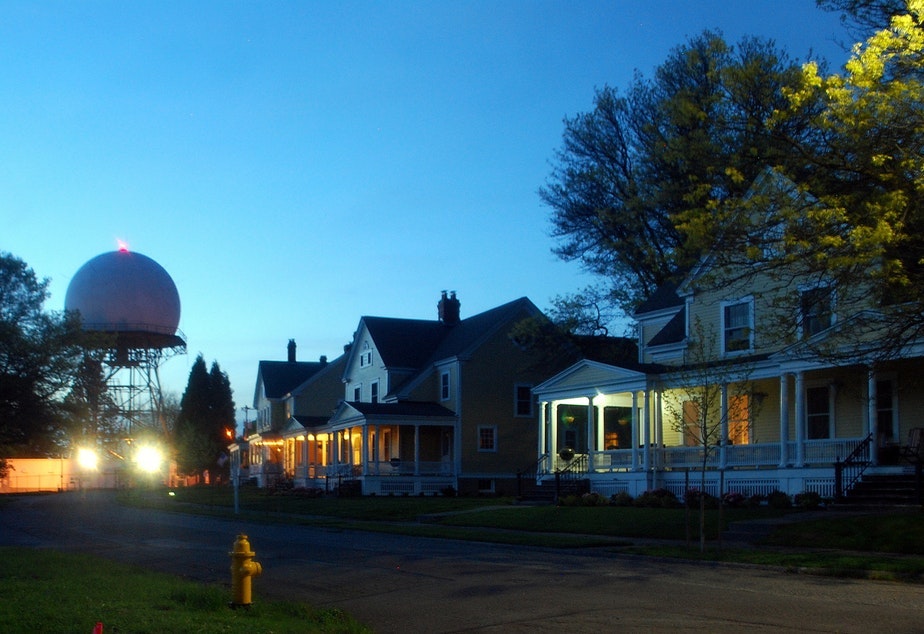Fort Lawton has just a few hoops left to get affordable housing

The legal challenges are largely over. But there's still lots of paperwork to do before 238 low-income homes are built on the former U.S. Army land next to Discovery Park.
Fort Lawton is all that remains of what was once a huge Army base. That base once covered all the land we know of as Discovery Park, which is over 700 acres. Now, there’s just 35 acres left in army hands.
The army plans to transfer that land to the city of Seattle, to use for housing and open space. City officials hope to have affordable housing built in Ft. Lawton by the late 2020s. But building that much housing there requires a rezone, which means the city had to hold a public hearing.
KUOW's Kim Malcom spoke to Joshua McNichols, who reported on the hearing.
Kim Malcolm: Joshua, what does the city want to do with this land?
Joshua McNichols: Catholic Housing Services will partner with the United Indian Tribes to build a three-story apartment building, which includes supportive services, for formerly homeless seniors and veterans. They’ll also build rowhouses or flats for low-income families.
Sponsored
Also, Habitat for Humanity will build 52 affordable homes that families with modest incomes could help build and actually purchase. They’ll be duplexes and rowhouses, and those residents will get a community meeting room, on-site management, and maybe even a computer lab.
There will be parking lots.
And 60% of the land would be preserved for recreation and open space. There’d be athletic fields for Seattle Public Schools, and trails and a protected area for a blue heron rookery. Four or five acres of forest will become part of Discovery Park.
KM: What did people have to say about that plan at the public hearing?
JM: Some said ‘look, this patch of forest in the middle of Magnolia is no place for housing.’ Marva Semet said it should become part of Discovery Park, a much-needed bit of nature in the middle of the city. “I’m here to oppose development of Fort Lawton," she told me. "My reasoning is to speak for all of the wildlife that cannot speak and come to any of these meetings.”
Sponsored
Renee Chu spoke in support of the housing. She brought up the history of the site to make the point that Fort Lawton isn’t wilderness. Originally, it was indigenous land, and then later, when it was an Army base, Discovery Park was once home to 20,000 soldiers. “This project is an opportunity to come full circle, I think that some of the housing was reserved for veterans and also indigenous people and I think that’s a beautiful tribute to what the land has served," she said, "And I think we should accommodate as many of our neighbors as possible.”
KM: So what’s the likelihood this gets built?
JM: Very likely. We’re approaching the end of a long process that began when the Army declared this land surplus in 2005. Officials have fought off legal challenges, and now this plan to put housing in the park has broad support from the mayor and the city council. Councilmember Teresa Mosqueda heads the committee in charge of rezoning the land. She reminded me that the Army’s gift of this land to Seattle includes language requiring Seattle to build affordable housing there. “We’re gonna miss an opportunity to get land at almost no cost from the federal government if we don’t act now," she said. "What we need to do now is move forward. It’s been 15 years in the making.”
KM: Fifteen years, that’s a long time. The number of people living outside has grown tremendously in that time. How has that changed this conversation?
JM: Today, there’s wider acceptance that the city should err on the side of more housing in debates like these.
Sponsored
The resistance to housing at Fort Lawton effectively limited the density of the housing that can be built there because at the time the city initiated its in-depth studies of that idea, it only studied a modest plan to build up to 238 homes on the 35-acre site. Today, the city is limited by the limited ambition of that earlier study.
In contrast, look at the way people are talking about 25 acres of land the Army wants to get rid of in the Interbay neighborhood.
The Interbay site is one third smaller than the Fort Lawton site, and at Interbay officials are talking about housing up to 5,000 people there and that’s on top of community centers and retail spaces and parks.
Last night at the public meeting, I heard activists making that point. They said this Fort Lawton debate is over, and we achieved something, but this is a missed opportunity, and next time we’ll be bolder.


